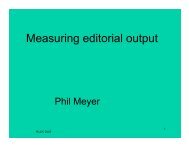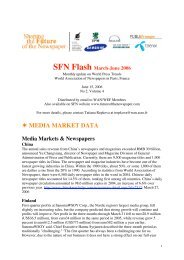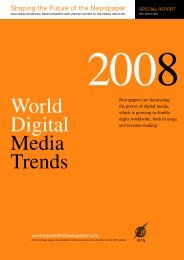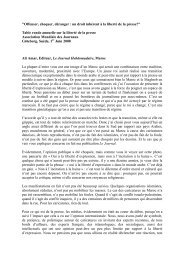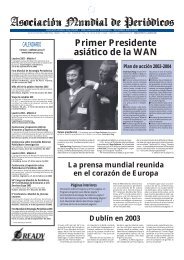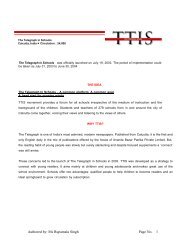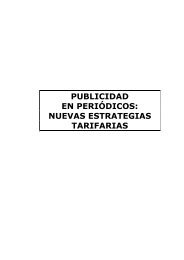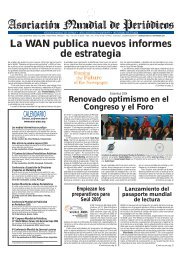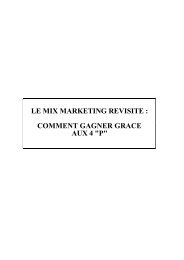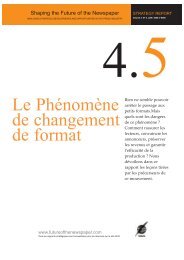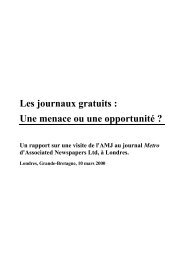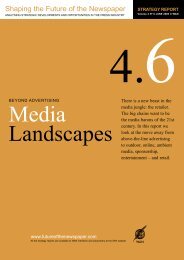WORLD PRESS TRENDS - World Association of Newspapers
WORLD PRESS TRENDS - World Association of Newspapers
WORLD PRESS TRENDS - World Association of Newspapers
You also want an ePaper? Increase the reach of your titles
YUMPU automatically turns print PDFs into web optimized ePapers that Google loves.
ARMENIA<br />
Commentary - IREX/ProMedia<br />
The Armenian news media are moving towards true financial<br />
independence, but they are moving slowly.<br />
The immediate situation <strong>of</strong> newspapers provides some insight.<br />
Most Armenian newspaper editors report that they benefited<br />
greatly from the 2002-2003 national election cycle, which began<br />
in October 2002 with local government elections and continued<br />
through the February 19 presidential elections and the<br />
Parliamentary elections on May 25, 2003.<br />
Many say they received money for political “advertising.”<br />
Unfortunately this takes the form <strong>of</strong> “tsakazugha,” or articles<br />
written to order. This has had a dramatic effect on editorial<br />
content. Most newspaper editors said they expected to increase<br />
their income, but after the election cycle, some fear they will<br />
fall on hard times and some foresee a contraction in the market<br />
for printed news media. An editor who was previously known<br />
for refusing to accept advertising recently asked about ad sales<br />
techniques.<br />
The election cycle brought several new entries to the newspaper<br />
market, primarily to provide political figures with information<br />
tools and propaganda forums. It also provided an opportunity<br />
for some newspapers to increase their circulation and the<br />
frequency <strong>of</strong> their publication.<br />
While most newspapers are increasing the amount <strong>of</strong><br />
advertising they carry, some are moving more quickly in that<br />
direction than others. They know that their long-term survival<br />
depends on operating as a viable business, not as a propaganda<br />
sheet for a political party or influential individuals.<br />
Several newspapers have dramatically increased their<br />
advertising content. Most notable are Novoe Vremya and Iravunk,<br />
as well as the centrist Azg daily. Novoe Vremya, a Russianlanguage<br />
broadsheet published twice a week, increased its<br />
advertising content from an average <strong>of</strong> 10%-15% in 2002, to 20%-<br />
30% in 2003. This is due to a decision by editor Ruben Satyan to<br />
hire an advertising sales staff and to begin printing a full page<br />
<strong>of</strong> classified advertising.<br />
In a recent issue, Novoe Vremya ran a full-page advertisement<br />
by an estate agency and then a half-page advertisement from<br />
an Armenian airline announcing new flights to Moscow. Satyan<br />
said it was part <strong>of</strong> a long-term advertising contract. Over the<br />
last year Novoe Vremya has increased its circulation by about<br />
3,000 copies to nearly 4,000, and it plans to begin publishing<br />
three times a week soon.<br />
Iravunk, which is opposed to the administration <strong>of</strong> President<br />
Robert Kocharian and is by far the most popular newspaper in<br />
Armenia, is an arm <strong>of</strong> the opposition Constitutional Rights<br />
Union party. It averages from 20% to 30% advertising, which is<br />
about 10% more than it carried a year ago. In early October<br />
2002 the publication contained 40%. The editor claims the<br />
newspaper is pr<strong>of</strong>itable and generates revenue for the party.<br />
Azg has experienced an advertising increase <strong>of</strong> between 5% and<br />
10%, but still averages only about 15% advertising.<br />
Aravot, another opposition daily, normally fluctuates between<br />
12% and 15% advertising, but occasionally has up to 25%. More<br />
than a year ago, Aravot began to print a colour cover one day a<br />
week in order to attract colour advertising. The editor reports<br />
this was a pr<strong>of</strong>itable move. Aravot is the only newspaper in<br />
Armenia to print in colour.<br />
Delavoy (Business) Express, a Russian-language weekly,<br />
continues to lead the field by averaging about 50% advertising.<br />
Delavoy Express and several other publications are popular<br />
because <strong>of</strong> their extensive classified advertising. One mid-<br />
October edition <strong>of</strong> Delavoy Express contained 65% advertising.<br />
The newspaper recently began publishing twice a week, and<br />
now appears on Wednesdays and Saturdays.<br />
Progress towards financial independence is hindered by four<br />
factors:<br />
First, the general economy <strong>of</strong> Armenia, while improving, still<br />
does not function like a typical market economy. Advertisers<br />
see little need to advertise because most have few rivals to worry<br />
about.<br />
Second, there is no tradition <strong>of</strong> advertising and newspapers are<br />
extremely politicised. Unfortunately, advertising in a<br />
publication is considered a political decision, not a business<br />
decision.<br />
Third, television advertising is very cheap compared to<br />
newspaper advertising, while <strong>of</strong>fering a much wider reach.<br />
Fourth, what can be characterised as the force <strong>of</strong> inertia, which<br />
is a deeply rooted cultural resistance to change.<br />
But the situation is changing. A 2002 survey showed that<br />
newspaper readership is stronger than once thought. The survey<br />
showed that while less than 5% <strong>of</strong> the population buy<br />
newspapers as their primary source <strong>of</strong> news, more than 50%<br />
read newspapers at least occasionally, and these readers use<br />
newspapers as their second or third source <strong>of</strong> information and<br />
news.<br />
The survey was conducted nationally, and concentrated on<br />
readers in the major population centres <strong>of</strong> Yerevan, Guimri,<br />
Vanadzor and Kapan. The survey suggested that while actual<br />
copy sales may be very low compared to the population,<br />
readership is broad and newspapers do exert considerable<br />
influence on the government, business, and the community at<br />
large.<br />
Distribution<br />
The distribution system on which all newspapers used to<br />
depend, Hymamul, has finally been privatised – a process that<br />
has been delayed for the past two years by political interference<br />
provoked by newspaper editors. The break-up <strong>of</strong> Haymamul<br />
has created eight new companies specialising in newspaper<br />
distribution on a small scale. It appears that market forces are<br />
at work and private businesses are moving to meet the need.<br />
However, most newspapers still depend on the state-owned<br />
distribution system, which consists <strong>of</strong> more than 200 kiosks.<br />
The best kiosks have been sold to private operators, which now<br />
sell cigarettes and other items as well as newspapers. Most<br />
editors are now seeking alternatives. Under the privatisation<br />
scheme kiosks are required to sell newspapers for five years,<br />
but many editors fear the kiosk may stop selling newspapers<br />
after only a year.<br />
<strong>WORLD</strong> ASSOCIATION OF NEWSPAPERS - <strong>WORLD</strong> <strong>PRESS</strong> <strong>TRENDS</strong> 2003 45




